Abstract
The clinical, laboratory, and histological findings of 50 patients with membranoproliferative glomerulonephritis are described. Three-quarters of the patients, who were mostly older children and young adults, presented clinically with a mixture of “nephritic” and “nephrotic” symptoms; the remaining quarter had no symptoms and were diagnosed after the discovery of proteinuria and microscopic haematuria.
Though this clinical picture may occur in other forms of glomerulonephritis, the patients described here were unified as a group by their glomerular morphological appearance—namely, a combination of mesangial proliferation and capillary wall thickening, mainly due to subendothelial accumulations of mesangial matrix.
In 68% serum C3 (β10-globulin) levels were reduced initially, while a further 16% subsequently showed a fall to abnormally low levels. All patients had substantial proteinuria, usually of moderately impaired selectivity, and all but one had haematuria in addition. Children frequently presented with an illness resembling acute nephritis, whereas adults usually had a nephrotic syndrome from the start.
In 31 patients, followed for periods of one to eight and a half years, serial measurements of glomerular filtration rate were made. Sixteen have experienced no deterioration of renal function, though their proteinuria continues unchanged. Fifteen have shown progressive deterioration; six of them are still well, six are on regular dialysis treatment, and three have died. Treatment with corticosteroids, azathioprine, or cyclophosphamide, alone or in combination, did not seem to influence the course of the disease, and another two patients died from complications of steroid therapy. The disease usually runs a chronic course and appears to be progressive.
Full text
PDF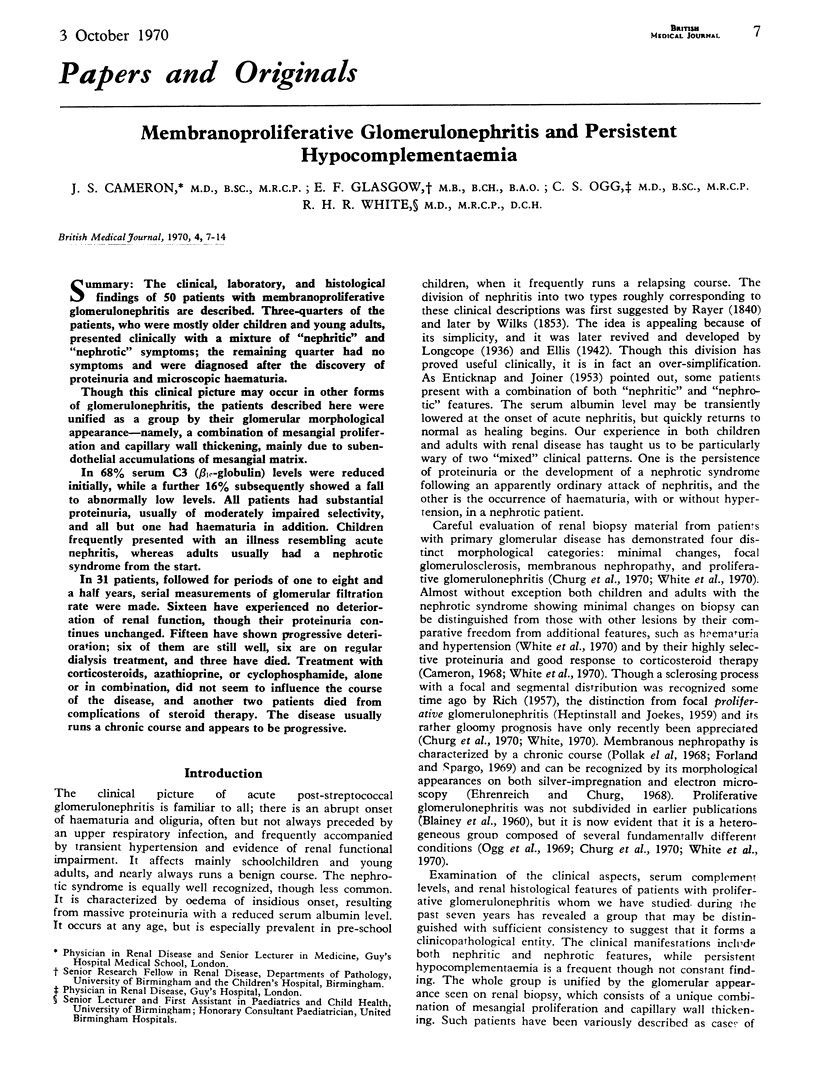
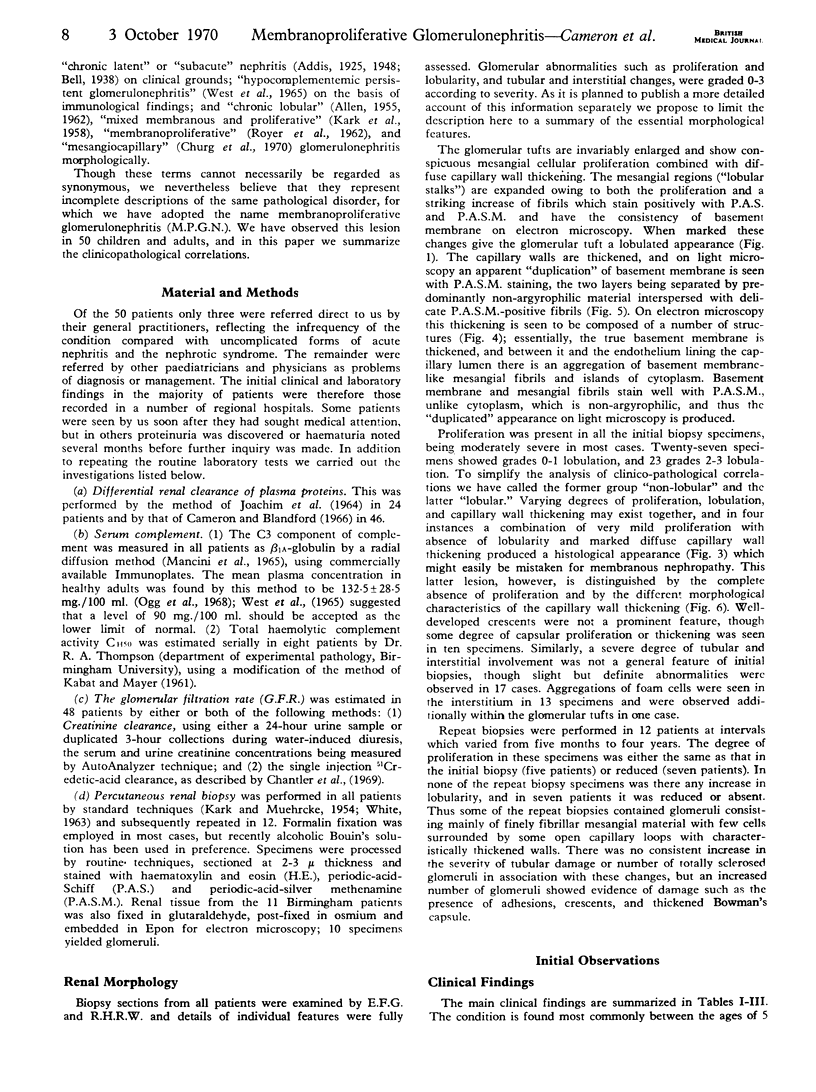
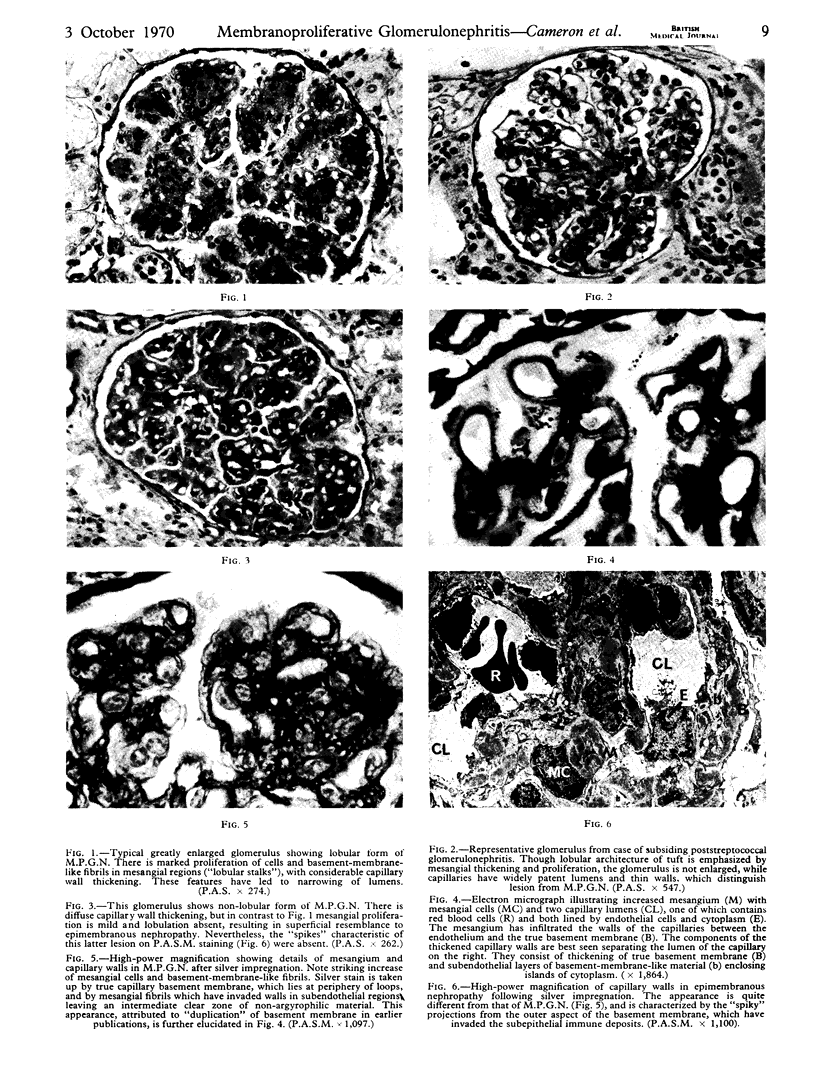
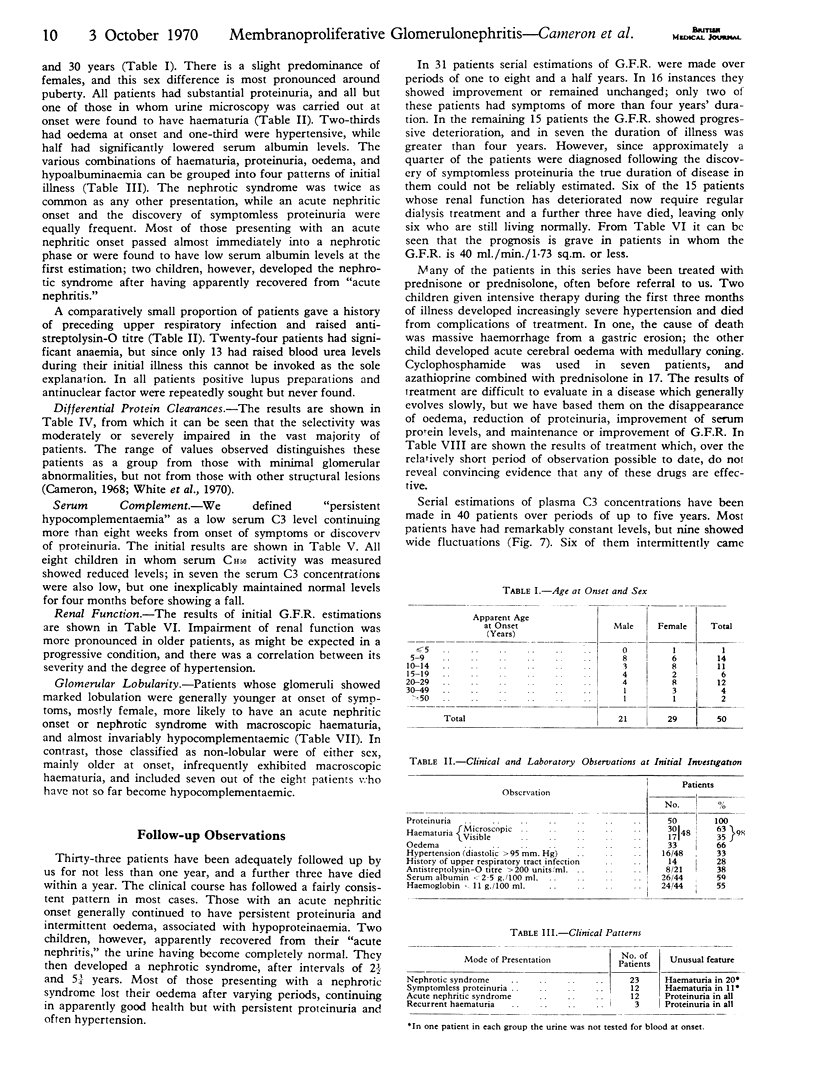
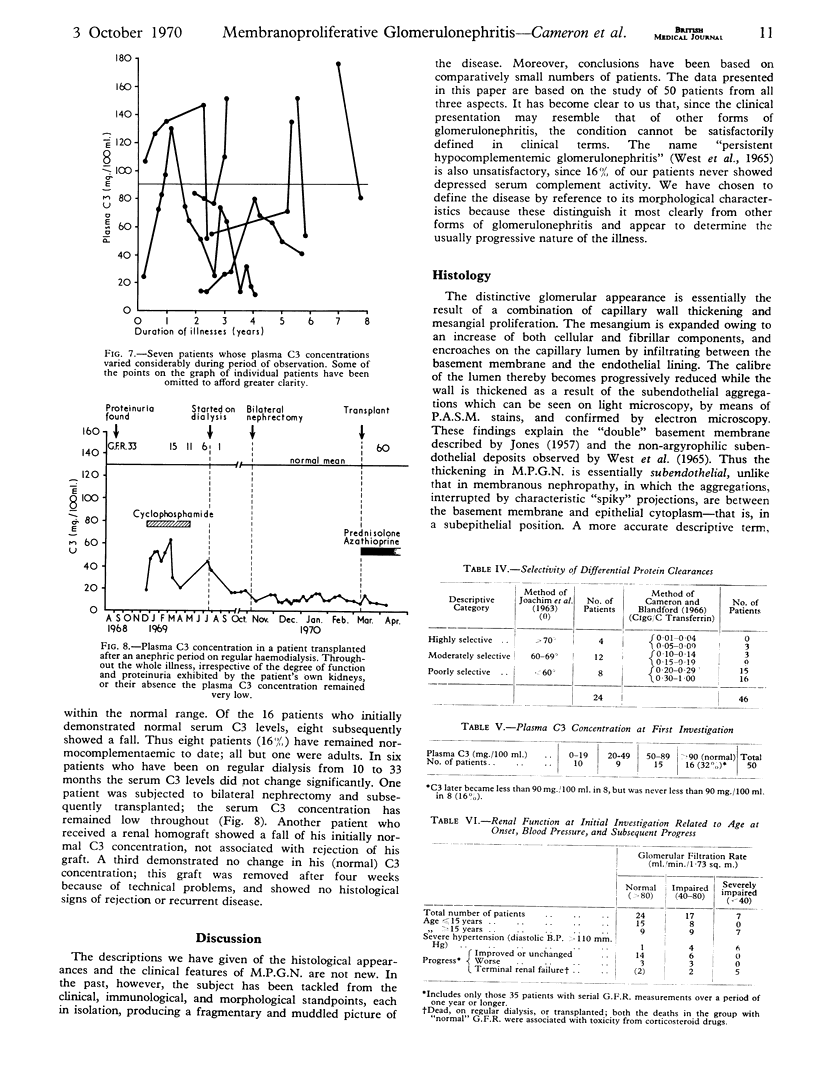
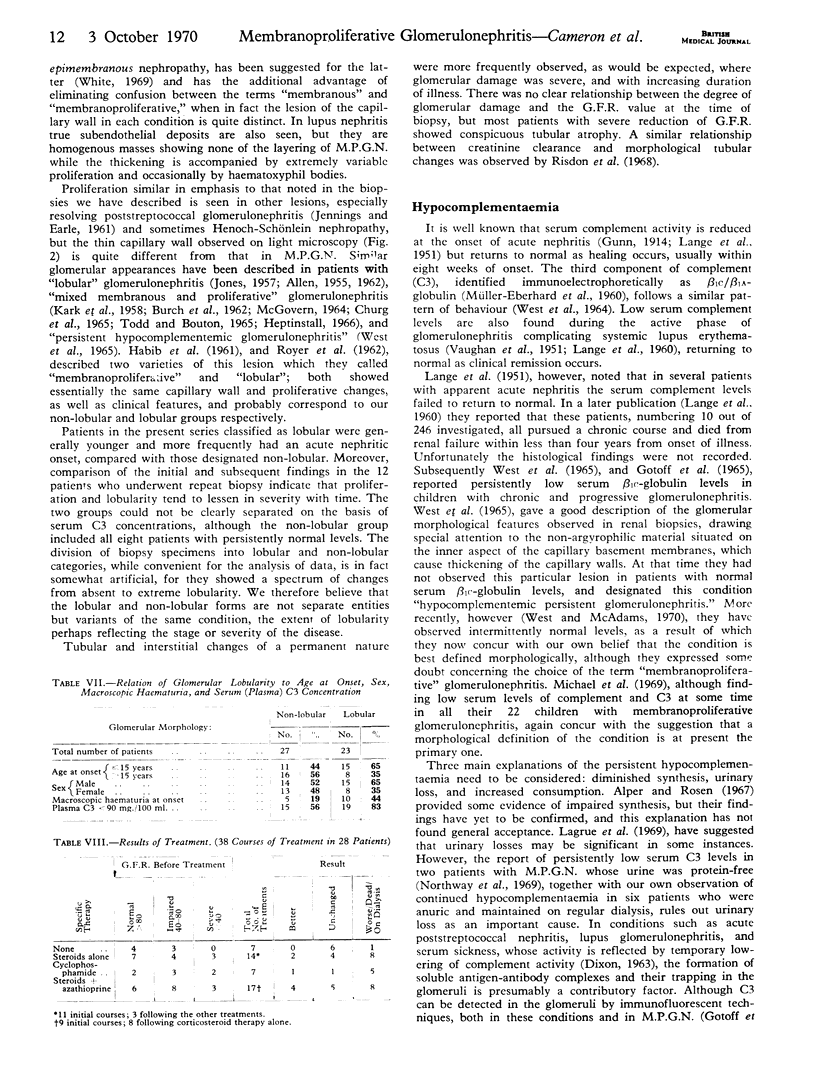

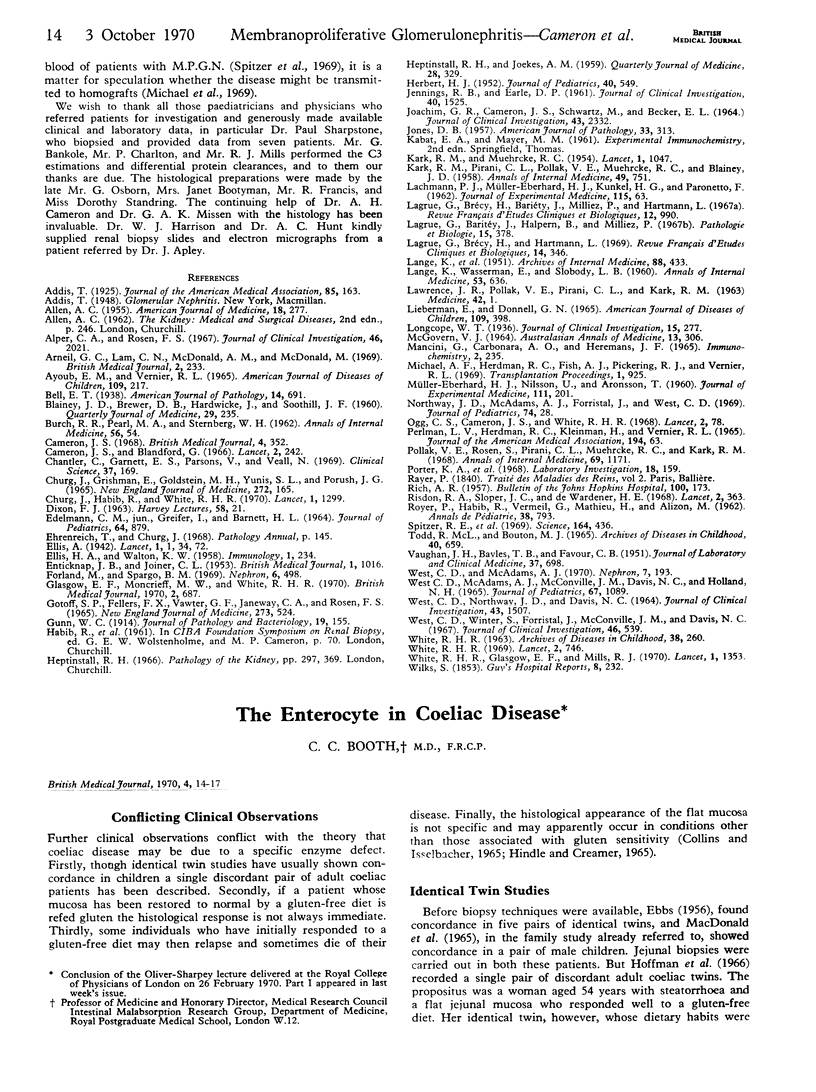
Images in this article
Selected References
These references are in PubMed. This may not be the complete list of references from this article.
- ALLEN A. C. The clinicopathologic meaning of the nephrotic syndrome. Am J Med. 1955 Feb;18(2):277–314. doi: 10.1016/0002-9343(55)90243-6. [DOI] [PubMed] [Google Scholar]
- AYOUB E. M., VERNIER R. L. BENIGN RECURRENT HEMATURIA. Am J Dis Child. 1965 Mar;109:217–223. doi: 10.1001/archpedi.1965.02090020219004. [DOI] [PubMed] [Google Scholar]
- Alper C. A., Rosen F. S. Alper CA, Rosen FS: Studies of the in vivo behavior of human C'3 in normal subjects and patients. J Clin Invest. 1967 Dec;46(12):2021–2034. doi: 10.1172/JCI105691. [DOI] [PMC free article] [PubMed] [Google Scholar]
- Arneil G. C., Lam C. N., McDonald A. M., McDonald M. Recurrent haematuria in 17 children. Br Med J. 1969 Apr 26;2(5651):233–235. doi: 10.1136/bmj.2.5651.233. [DOI] [PMC free article] [PubMed] [Google Scholar]
- BLAINEY J. D., BREWER D. B., HARDWICKE J., SOOTHILL J. F. The nephrotic syndrome. Diagnosis by renal biopsy and biochemical and immunological analyses related to the response to steroid therapy. Q J Med. 1960 Apr;29:235–256. [PubMed] [Google Scholar]
- BURCH R. R., PEARL M. A., STERNBERG W. H. A clinicopathological study of the nephrotic syndrome. Ann Intern Med. 1962 Jan;56:54–67. doi: 10.7326/0003-4819-56-1-54. [DOI] [PubMed] [Google Scholar]
- Bell E. T. A clinical and pathological study of subacute and chronic glomerulonephritis, including lipoid nephrosis. Am J Pathol. 1938 Nov;14(6):691–736.5. [PMC free article] [PubMed] [Google Scholar]
- CHURG J., GRISHMAN E., GOLSTEIN M. H., YUNIS S. L., PORUSH J. G. IDIOPATHIC NEPHROTIC SYNDROME IN ADULTS. A STUDY AND CLASSIFICATION BASED ON RENAL BIOPSIES. N Engl J Med. 1965 Jan 28;272:165–174. doi: 10.1056/NEJM196501282720401. [DOI] [PubMed] [Google Scholar]
- Cameron J. S., Blandford G. The simple assessment of selectivity in heavy proteinuria. Lancet. 1966 Jul 30;2(7457):242–247. doi: 10.1016/s0140-6736(66)92539-6. [DOI] [PubMed] [Google Scholar]
- Cameron J. S. Histology, protein clearances, and response to treatment in the nephrotic syndrome. Br Med J. 1968 Nov 9;4(5627):352–356. doi: 10.1136/bmj.4.5627.352. [DOI] [PMC free article] [PubMed] [Google Scholar]
- Chantler C., Garnett E. S., Parsons V., Veall N. Glomerular filtration rate measurement in man by the single injection methods using 51Cr-EDTA. Clin Sci. 1969 Aug;37(1):169–180. [PubMed] [Google Scholar]
- Churg J., Habib R., White R. H. Pathology of the nephrotic syndrome in children: a report for the International Study of Kidney Disease in Children. Lancet. 1970 Jun 20;760(1):1299–1302. doi: 10.1016/s0140-6736(70)91905-7. [DOI] [PubMed] [Google Scholar]
- DIXON F. J. THE ROLE OF ANTIGEN-ANTIBODY COMPLEXES IN DISEASE. Harvey Lect. 1963;58:21–52. [PubMed] [Google Scholar]
- EDELMANN C. M., Jr, GREIFER I., BARNETT H. L. THE NATURE OF KIDNEY DISEASE IN CHILDREN WHO FAIL TO RECOVER FROM APPARENT ACUTE GLOMERULONEPHRITIS. J Pediatr. 1964 Jun;64:879–887. doi: 10.1016/s0022-3476(64)80645-4. [DOI] [PubMed] [Google Scholar]
- ELLIS H. A., WALTON K. W. Variations in serum complement in the nephrotic syndrome and other forms of renal disease. Immunology. 1958 Jul;1(3):234–250. [PMC free article] [PubMed] [Google Scholar]
- ENTICKNAP J. P., JOINER C. L. Bright's disease: an attempt at a statistical assessment of the classification proposed by Ellis. Br Med J. 1953 May 9;1(4818):1016–1020. doi: 10.1136/bmj.1.4818.1016. [DOI] [PMC free article] [PubMed] [Google Scholar]
- Forland M., Spargo B. H. Clinicopathological correlations in idiopathic nephrotic syndrome with membranous nephropathy. Nephron. 1969;6(4):498–525. doi: 10.1159/000179748. [DOI] [PubMed] [Google Scholar]
- GOTOFF S. P., FELLERS F. X., VAWTER G. F., JANEWAY C. A., ROSEN F. S. THE BETA-1C GLOBULIN IN CHILDHOOD NEPHROTIC SYNDROME: LABORATORY DIAGNOSIS OF PROGRESSIVE GLOMERULONEPHRITIS. N Engl J Med. 1965 Sep 2;273:524–529. doi: 10.1056/NEJM196509022731004. [DOI] [PubMed] [Google Scholar]
- Glasgow E. F., Moncrieff M. W., White R. H. Symptomless haematuria in childhood. Br Med J. 1970 Jun 20;2(5711):687–692. doi: 10.1136/bmj.2.5711.687. [DOI] [PMC free article] [PubMed] [Google Scholar]
- HEBERT H. J. Acute glomerulonephritis in childhood; a study of the late prognosis of twenty-seven cases. J Pediatr. 1952 May;40(5):549–557. doi: 10.1016/s0022-3476(52)80144-1. [DOI] [PubMed] [Google Scholar]
- HEPTINSTALL R. H., JOEKES A. M. Focal glomerulonephritis. A study based on renal biopsies. Q J Med. 1959 Jul;28:329–346. [PubMed] [Google Scholar]
- JENNINGS R. B., EARLE D. P. Post-streptococcal glomerulo-nephritis: histopathologic and clinical studies of the acute, subsiding acute and early chronic latent phases. J Clin Invest. 1961 Aug;40:1525–1595. doi: 10.1172/JCI104382. [DOI] [PMC free article] [PubMed] [Google Scholar]
- JOACHIM G. R., CAMERON J. S., SCHWARTZ M., BECKER E. L. SELECTIVITY OF PROTEIN EXCRETION IN PATIENTS WITH THE NEPHROTIC SYNDROME. J Clin Invest. 1964 Dec;43:2332–2346. doi: 10.1172/JCI105107. [DOI] [PMC free article] [PubMed] [Google Scholar]
- JONES D. B. Nephrotic glomerulonephritis. Am J Pathol. 1957 Mar-Apr;33(2):313–329. [PMC free article] [PubMed] [Google Scholar]
- KARK R. M., MUEHRCKE R. C. Biopsy of kidney in prone position. Lancet. 1954 May 22;266(6821):1047–1049. doi: 10.1016/s0140-6736(54)91618-9. [DOI] [PubMed] [Google Scholar]
- KARK R. M., PIRANI C. L., POLLAK V. E., MUEHRCKE R. C., BLAINEY J. D. The nephrotic syndrome in adults: a common disorder with many causes. Ann Intern Med. 1958 Oct;49(4):751–754. doi: 10.7326/0003-4819-49-4-751. [DOI] [PubMed] [Google Scholar]
- LANGE K., WASSERMAN E., SLOBODY L. B. The significance of serum complement levels for the diagnosis and prognosis of acute and subacute glomerulonephritis and lupus erythematosus disseminatus. Ann Intern Med. 1960 Oct;53:636–646. doi: 10.7326/0003-4819-53-4-636. [DOI] [PubMed] [Google Scholar]
- LIEBERMAN E., DONNELL G. N. RECOVERY OF CHILDREN WITH ACUTE GLOMERULONEPHRITIS. Am J Dis Child. 1965 May;109:398–407. doi: 10.1001/archpedi.1965.02090020400004. [DOI] [PubMed] [Google Scholar]
- Lagrue G., Bariéty J., Halpern B., Milliez P. Le complément dans les néphropathies humaines. Pathol Biol. 1967 Apr;15(7):378–383. [PubMed] [Google Scholar]
- Lagrue G., Brécy H., Bariéty J., Milliez P., Hartmann L. Dosage des fractions du complément (C'1, C'2, C'3, C'4) dans les glomérulopathies hypocomplémentaires. Rev Fr Etud Clin Biol. 1967 Dec;12(10):990–995. [PubMed] [Google Scholar]
- Lagrue G., Brécy H., Hartmann L. La complémenturie dans les glomérulopathies humaines. Rev Fr Etud Clin Biol. 1969 Apr;14(4):346–353. [PubMed] [Google Scholar]
- Longcope W. T. STUDIES OF THE VARIATIONS IN THE ANTISTREPTOLYSIN TITER OF THE BLOOD SERUM FROM PATIENTS WITH HEMORRHAGIC NEPHRITIS. II. OBSERVATIONS ON PATIENTS SUFFERING FROM STREPTOCOCCAL INFECTIONS, RHEUMATIC FEVER AND ACUTE AND CHRONIC HEMORRHAGIC NEPHRITIS. J Clin Invest. 1936 May;15(3):277–294. doi: 10.1172/JCI100777. [DOI] [PMC free article] [PubMed] [Google Scholar]
- MCGOVERN V. J. PERSISTENT NEPHROTIC SYNDROME: A RENAL BIOPSY STUDY. Australas Ann Med. 1964 Nov;13:306–312. doi: 10.1111/imj.1964.13.4.306. [DOI] [PubMed] [Google Scholar]
- MULLER-EBERHARD H. J., NILSSON U., ARONSSON T. Isolation and characterization of two beta1-glycoproteins of human serum. J Exp Med. 1960 Feb 1;111:201–215. doi: 10.1084/jem.111.2.201. [DOI] [PMC free article] [PubMed] [Google Scholar]
- Mancini G., Carbonara A. O., Heremans J. F. Immunochemical quantitation of antigens by single radial immunodiffusion. Immunochemistry. 1965 Sep;2(3):235–254. doi: 10.1016/0019-2791(65)90004-2. [DOI] [PubMed] [Google Scholar]
- Michael A. F., Herdman R. C., Fish A. J., Pickering R. J., Vernier R. L. Chronic membranoproliferative glomerulonephritis with hypocomplementemia. Transplant Proc. 1969 Dec;1(4):925–932. [PubMed] [Google Scholar]
- Northway J. D., McAdams A. J., Forristal J., West C. D. A "silent" phase of hypocomplementemic persistent nephritis detectable by reduced serum beta-1c-globulin levels. J Pediatr. 1969 Jan;74(1):28–38. doi: 10.1016/s0022-3476(69)80005-3. [DOI] [PubMed] [Google Scholar]
- Perlman L. V., Herdman R. C., Kleinman H., Vernier R. L. Poststreptococcal glomerulonephritis. A ten-year follow-up of an epidemic. JAMA. 1965 Oct 4;194(1):63–70. doi: 10.1001/jama.194.1.63. [DOI] [PubMed] [Google Scholar]
- Pollak V. E., Rosen S., Pirani C. L., Muehrcke R. C., Kark R. M. Natural history of lipoid nephrosis and of membranous glomerulonephritis. Ann Intern Med. 1968 Dec;69(6):1171–1196. doi: 10.7326/0003-4819-69-6-1171. [DOI] [PubMed] [Google Scholar]
- Porter K. A., Andres G. A., Calder M. W., Dossetor J. B., Hsu K. C., Rendall J. M., Seegal B. C., Starzl T. E. Human renal transplants. II. Immunofluorescent and immunoferritin studies. Lab Invest. 1968 Feb;18(2):159–171. [PubMed] [Google Scholar]
- RICH A. R. A hitherto undescribed vulnerability of the juxtamedullary glomeruli in lipoid nephrosis. Bull Johns Hopkins Hosp. 1957 Apr;100(4):173–186. [PubMed] [Google Scholar]
- Risdon R. A., Sloper J. C., De Wardener H. E. Relationship between renal function and histological changes found in renal-biopsy specimens from patients with persistent glomerular nephritis. Lancet. 1968 Aug 17;2(7564):363–366. doi: 10.1016/s0140-6736(68)90589-8. [DOI] [PubMed] [Google Scholar]
- Spitzer R. E., Vallota E. H., Forristal J., Sudora E., Stitzel A., Davis N. C., West C. D. Serum C'3 lytic system in patients with glomerulonephritis. Science. 1969 Apr 25;164(3878):436–437. doi: 10.1126/science.164.3878.436. [DOI] [PubMed] [Google Scholar]
- Todd R. M., Bouton M. J. Nephrosis: a clinical and histological study of 38 children. Arch Dis Child. 1965 Dec;40(214):659–665. doi: 10.1136/adc.40.214.659. [DOI] [PMC free article] [PubMed] [Google Scholar]
- WEST C. D., NORTHWAY J. D., DAVIS N. C. SERUM LEVELS OF BETA-1C GLOBULIN, A COMPLEMENT COMPONENT, IN THE NEPHRITIDES, LIPOID NEPHROSIS, AND OTHER CONDITIONS. J Clin Invest. 1964 Aug;43:1507–1517. doi: 10.1172/JCI105027. [DOI] [PMC free article] [PubMed] [Google Scholar]
- WHITE R. H. Observations on percutaneous renal biopsy in children. Arch Dis Child. 1963 Jun;38:260–266. doi: 10.1136/adc.38.199.260. [DOI] [PMC free article] [PubMed] [Google Scholar]
- West C. D., McAdams A. J. Serum beta-1C globulin levels in persistent glomerulonephritis with low serum complement: variability unrelated to clinical course. Nephron. 1970;7(3):193–202. doi: 10.1159/000179822. [DOI] [PubMed] [Google Scholar]
- West C. D., Winter S., Forristal J., McConville J. M., Davis N. C. Evidence for in vivo breakdown of beta-10-globulin in hypocomplementemic glomerulonephritis. J Clin Invest. 1967 Apr;46(4):539–548. doi: 10.1172/JCI105555. [DOI] [PMC free article] [PubMed] [Google Scholar]
- White R. H. Epimembranous nephropathy. Lancet. 1969 Oct 4;2(7623):746–746. doi: 10.1016/s0140-6736(69)90458-9. [DOI] [PubMed] [Google Scholar]
- White R. H., Glasgow E. F., Mills R. J. Clinicopathological study of nephrotic syndrome in childhood. Lancet. 1970 Jun 27;1(7661):1353–1359. doi: 10.1016/s0140-6736(70)91268-7. [DOI] [PubMed] [Google Scholar]








